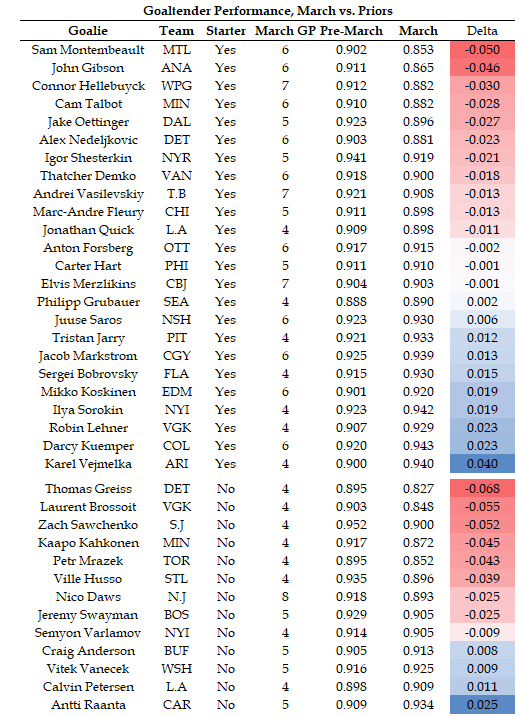Mar 17, 2022
March has been a miserable month for NHL goalies
T.S. Eliot wrote that "April is the cruelest month," but for NHL goaltenders in 2022, that designation belongs to March. Travis Yost delves into an awful month for netminders.
By Travis Yost
March 2022 is shaping up to be the month where goaltending fell apart across the National Hockey League.
An interesting observation made this week on a precipitous decline in league-wide save percentage caught my eye. We’ve seen several clubs beaten down because of an inability to make a save in recent weeks – the Toronto Maple Leafs (86.7 stop rate), Minnesota Wild (85.9 stop rate), and Vegas Golden Knights (87.2 stop rate) are talented teams that have watched their goaltending capitulate in March.
If we look month-over-month performance, we see how effective shooters are at beating goaltenders right now. What’s interesting is that this is a complete reversal of a trend we normally see during regular seasons – scoring tends to be the highest early on, with teams playing looser defensively and officiating teams more inclined to call penalties.
This year, it’s the opposite:

March has seen a pronounced move to the downside, with teams stopping 89.6 per cent of shots on average – a number you would expect from a journeyman backup goaltender over the course of a regular season.
Naturally, the first question we should explore is whether offensive pressure has materially changed. If goaltenders are facing a tougher profile of shots (be it higher volumes, better shot quality against, or a combination of the two), we would see a surge in expected goal scoring.
Here is what that looks like month-over-month:

Two notable things stand out here. The first is that there has been divergence between rate-scoring and expected scoring at even strength for a couple of months. Because expected scoring is still flat, the inference is that shooters are simply more effective right now. We may not know if that is a byproduct of better playmaking in the offensive zone or weaker goaltending, but we can rule out that bluelines are being more accommodating in the defensive zone. There’s a similar finding on the power play, too – shooters are just finding the back of the net with regularity right now.
Another thing worth exploring is the quality of goaltenders who are currently getting the crease. Among other things, if a swath of injuries – and we have certainly seen a few of them; Toronto and Vegas have both lost starting goalies – have temporarily diminished the talent at the position, we would expect save percentage to drop.
So, are platoon options and backups getting more minutes? Let’s look there:

This explains some of what’s going on, though the direction is not as strong as I would have suspected. Starters are playing less in March, though in line with what we saw during December and January during COVID-19 outbreaks. The backup options across the league have certainly underwhelmed – non-starters are stopping less than 89 per cent of shots faced, and when they are playing 41 per cent of the available games, that’s going to have a notable drag on league-wide save percentages.
What else explains it? The reality is that a handful of starters and their replacements have been awful– be it random chance, under performance, or a combination of the two. So much so that they are pulling league averages down in an aggressive way.

When you look at March performance at the individual level, you see nearly 60 per cent of starting goaltenders under-water relative to earlier parts of the season – that number is as high as 70 per cent for backup and third-string options who have seen a lot of the net (for a variety of reasons) this month.
But look at how dramatic some of the drawdowns have been. Goaltenders like Montreal’s Sam Montembeault, Detroit’s Thomas Greiss, and Vegas’ Laurent Brossoit have been borderline unplayable this month. Goaltenders we normally see as high-end performers – think Anaheim’s John Gibson, or Winnipeg’s Connor Hellebuyck – are also in an extraordinary funk. What you are left with is very few goaltenders, like Arizona’s Karel Vejmelka and Carolina’s Antti Raanta who are on the upswing.
What we have is a confluence of factors contributing to more scoring and weaker goaltending. Health and availability (or lack thereof) have certainly been contributory. But the great goaltenders just aren’t making saves right now, and their backups aren’t playing any better.
I doubt the forwards are complaining any. But let’s not ask the coaches what they think.
Data via Natural Stat Trick, NHL.com, Evolving Hockey

